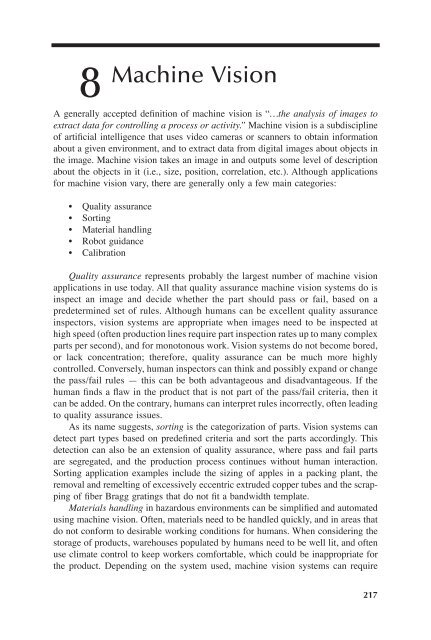Image Acquisitionand Proces
Create successful ePaper yourself
Turn your PDF publications into a flip-book with our unique Google optimized e-Paper software.
8<br />
Machine Vision<br />
A generally accepted deÞnition of machine vision is “…the analysis of images to<br />
extract data for controlling a process or activity.” Machine vision is a subdiscipline<br />
of artiÞcial intelligence that uses video cameras or scanners to obtain information<br />
about a given environment, and to extract data from digital images about objects in<br />
the image. Machine vision takes an image in and outputs some level of description<br />
about the objects in it (i.e., size, position, correlation, etc.). Although applications<br />
for machine vision vary, there are generally only a few main categories:<br />
• Quality assurance<br />
• Sorting<br />
• Material handling<br />
• Robot guidance<br />
• Calibration<br />
Quality assurance represents probably the largest number of machine vision<br />
applications in use today. All that quality assurance machine vision systems do is<br />
inspect an image and decide whether the part should pass or fail, based on a<br />
predetermined set of rules. Although humans can be excellent quality assurance<br />
inspectors, vision systems are appropriate when images need to be inspected at<br />
high speed (often production lines require part inspection rates up to many complex<br />
parts per second), and for monotonous work. Vision systems do not become bored,<br />
or lack concentration; therefore, quality assurance can be much more highly<br />
controlled. Conversely, human inspectors can think and possibly expand or change<br />
the pass/fail rules — this can be both advantageous and disadvantageous. If the<br />
human Þnds a ßaw in the product that is not part of the pass/fail criteria, then it<br />
can be added. On the contrary, humans can interpret rules incorrectly, often leading<br />
to quality assurance issues.<br />
As its name suggests, sorting is the categorization of parts. Vision systems can<br />
detect part types based on predeÞned criteria and sort the parts accordingly. This<br />
detection can also be an extension of quality assurance, where pass and fail parts<br />
are segregated, and the production process continues without human interaction.<br />
Sorting application examples include the sizing of apples in a packing plant, the<br />
removal and remelting of excessively eccentric extruded copper tubes and the scrapping<br />
of Þber Bragg gratings that do not Þt a bandwidth template.<br />
Materials handling in hazardous environments can be simpliÞed and automated<br />
using machine vision. Often, materials need to be handled quickly, and in areas that<br />
do not conform to desirable working conditions for humans. When considering the<br />
storage of products, warehouses populated by humans need to be well lit, and often<br />
use climate control to keep workers comfortable, which could be inappropriate for<br />
the product. Depending on the system used, machine vision systems can require<br />
217



